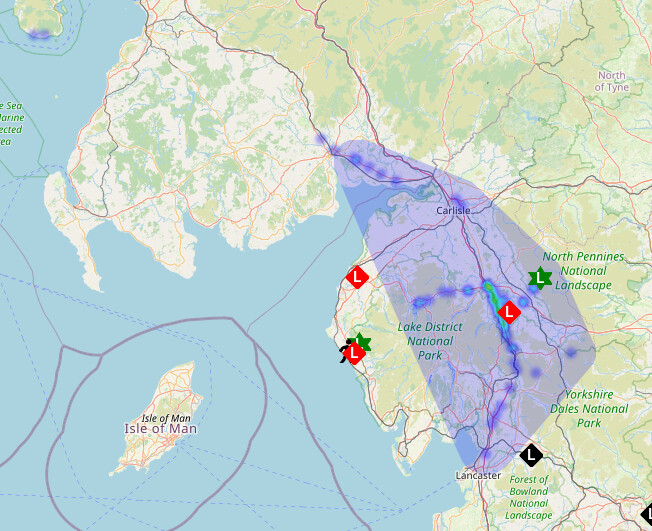I’m not sure that back calculating for the occasional distant ping using a crude model like this will yield any useful information. It will be interesting to see what the predicted coverage looks like if you do that though.
It turns out to be quite hard to shift the coverage area significantly. So far I’ve not managed to get it to get even close to including Arran, all that happens is that the existing green areas become a bit more solid. I might look into writing some software to build my own persistent database of received packets. A winter project, methinks.
APRS.fi already does this on a monthly basis but a longer timeframe would be interesting. Of course transient anomalous propagation of various types will flatter the results.
Yay! Glad you found this to be the case, too!
Looking forward to this being available. Currently collecting bits to deploy a digipeater in the hills up here in GM land.
I got 246km but it was a one off and thought to be aircraft scatter.
I’m not sure if the balloon pings count for records, they have a fair bit of altitude to add to the horizontal distance!
Spoke with him, he said that he is implementing it soon in the normal IGate firmware.
For parts or inputs check out my previous post.
No distance record, but to add to the aircraft scatter theory. I had just flashed a replacement digipeater for my -14 I was still editing the config. I had powered down my -12 igate to avoid any problems when booting the new board, it was in my shack lying with antenna horizontal on the bench, I should add my QTH is in a valley. And to my amazement it managed to pinged G3CWI-2, 47 miles away, twice a couple of minutes apart, not something I would expect at home even with an antenna on the roof.
On checking flight Radar, a light aircraft had just passed over at the time of the 2 pings. Leading me assume the pings were scatter of this aircraft.
Gosh! A PA38 aircraft doing 146 knots ground speed? The most I ever got out of a PA38 was about 95 knots airspeed, so that suggests a 50kt+ tailwind. Not sure I’d be doing a training flight in those conditions.
I am curious as to whether aircraft scatter is a feasible propagation mode for LoRa. The transmissions are quite long ( 2-3 seconds?) and I would have thought that the phase incoherences of a frequency agile signal bounced off a moving reflector for so long would be troublesome.
I had thought the same John. But as Richard said, there are satellite LoRa links so Doppler can’t be too much of an issue. If it works from a satellite moving at 15000knots it should be much less from a plane moving at 150knots. There could well be other effects that would make the signal integrity much worse. Probably there’s some reflections that are marginal irrespective of signal strength compared with others.
The difference is that the satellite is not a reflector, it is a repeater, so the only artifact of the satellite’s relative motion is Doppler shift. The phase incoherence, if it exists, is an additional artefact arising from arbitrary reflections from a moving object. I’m thinking of the way that auroral reflections lose phase coherence. But then I am no RF engineer!
I did note it had taken off from RAF Shawbury which seemed a bit odd, as that’s an RAF helicopter pilot training base
FR24 often gets departure or arrival fields wrong, especially for light aircraft and small airfields. Possible (more likely?) the departure was Sleap, which is closer to where the track for the aircraft starts.
Yes, almost certainly Sleap (a lovely airfield) and I suspect that the implausible speed was due to errors in triangulation if, as is likely, the aircraft was not equipped with ADS-B.
Someone has asked me if I will be making up another batch of trackers. The answer is it depends on how many are interested. If you do want one, DM me to get added to my waiting list. UK activators only.
I see that John G3WGV’s new digipeater is starting to show its worth. Carnforth to Dumfries and beyond.
You beat me to it! G0PEB-4 has been tracked continuously since he left Keswick at the crack of dawn today. He’s now almost at Birmingham with a track distance of >250km, which may be a record. Happy that G3WGV-11 was able to play its part.
Update:
G0PEB’s uninterrupted track extended to 420km before contact was lost on the M4 (a place where little 100mW wireless wiggles fear to tread it seems). That’s an impressive distance.
Ducting. Classic High Pressure phenomenon. Looking at the data it appears that John’s digipeater is not hearing as well as the receiving stations.
M0MZB-14 (solar power digipeater on Cold Fell in West Cumbria) went off air suddenly this morning at 0922, with good battery level. Will be a couple of days before i head up to find out what broke.
It’s a pity, as i was almost getting enough confidence to re-site to G/LD-025 as it had been operating steadily for over a week.



